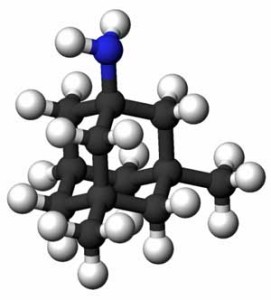Memantine (Axura, Akatinol, Namenda) is…
An NMDA receptor antagonist that is FDA-approved to treat moderate to severe Alzheimer’s disease. A derivative of amantadine, memantine has been used for over 20 years to treat Alzheimer’s disease. Memantine blocks glutamate from exciting the NMDA receptors that are believed to contribute to central sensitization. Memantine also may down-regulate 5-HT3 receptors that can contribute to pain sensitivity, enhance dopamine activity, and inhibit neuroinflammation.
Located in the dorsal horn of the spinal cord, the NMDA receptors are found in prime territory to regulate pain levels. Dorsal horn neurons receive and filter sensory information from the body and transmit it to the brain. Over-activation of these neurons is believed to contribute to hypersensitivity pain states (central sensitization).
NMDA receptor-affecting drugs such as ketamine are often used in anesthesia. . (Dextromethorphan, methadone, and tramadol are other NMDA receptor antagonists.).
Long-term use of some NMDA receptor-affecting drugs has proved problematic; one hope has been that memantine will be a better long-term solution.
A relatively new drug memantine is being assessed in a wide variety of conditions including ADHD, neuropathic pain, anxiety, epilepsy, SLS, depression, multiple sclerosis, autism, migraine, amyotrophic lateral sclerosis, and others.
Memantine reduced neuropathic pain, improved cognition in laboratory animals, and reduced pro-inflammatory cytokine expression and neurological issues in multiple sclerosis animal models. Memantine improved cognition and speech fluency in a large Alzheimer’s study. Memantine reduced central nervous system methylmercury damage in laboratory animals.
Fibromyalgia and Chronic Fatigue Syndrome (ME/CFS) Studies
Studies indicating raised glutamate levels in the insula, hippocampus, basal ganglia, posterior cingulate cortex regions (the ‘pain matrix’) in the brains of FM patients have ignited some interest in memantine. Memantine improved cognition, depression, and global function and produced a non-significant trend toward reduced pain in a small (n=10), preliminary, uncontrolled trial.
Memantine and Lyrica were hypothesized to have synergistic effects in fibromyalgia but no trials have yet occurred. A systematic review of 11 memantine trials for chronic pain found little to recommend. While the authors stated that the rationale for using memantine was clear, the trials were very small – leading the authors to conclude that while memantine may be helpful for pain they couldn’t conclude it was.
Side Effects
According to Wikipedia, memantine is generally well tolerated. (However, check out Wikipedia’s page on NMDA receptor antagonists). Spanish fibromyalgia researchers report “Memantine has shown a very low incidence of side effects in clinical trials on humans”. A systematic review of memantine trials in chronic pain cite an increased risk of dizziness.
Adverse drug reactions can include confusion, dizziness, drowsiness, headache, insomnia, agitation, and/or hallucinations, and others. Overdoses of NMDA receptor antagonists can cause hallucinations, paranoid delusions, confusion, difficulty concentrating, agitation, mood alterations, nightmares, catatonia, anesthesia, and learning and memory problems. Abusers of these drugs can have significant cognitive issues.







